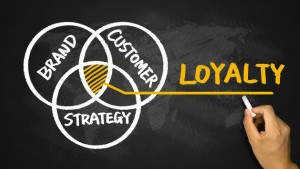How Do You Know If You’ve Achieved True Brand Loyalty?
A consumer is at the store, faced with a specific need and a wall full of potential solutions, looking to make a purchase decision.
This is the moment of truth for any brand – the first barrier to purchase has been crossed – the consumer is in the door and is considering that brand as an option. But success has not yet been achieved, as there are a number of factors and situations which play into a purchase decision, all of which are running through their mind as they work through the decision.
But just then, another consumer walks down the aisle toward our subject, heading straight toward the same wall of products. The difference in this instance, however, is that the second consumer heads straight toward a particular brand, without hesitation or pause.
Curious at how such a quick decision could be made, the first consumer asks the second what made it seem so easy?
“I knew exactly which brand I would get on my way here,” the second one says. “To be honest, I couldn’t even tell you what other brands make this product. It’s Brand X for me, every time.”
There it is – the goal of any brand in a competitive marketplace. To have consumers who put your brand above all others without question. It takes time and effort to achieve and maintain. It’s brand loyalty.
Consumers become loyal to certain products and brands for a number of reasons.
In some instances, the loyalty is driven by prudence. If a product provides consistently superior quality or a good price, then it’s common sense that a consumer would establish brand loyalty. Who wouldn’t lean toward the brand that is bigger, better, faster or cheaper than the competition?
The problem comes when this gets mistaken for true brand loyalty. In reality, it rarely has anything to do with the brand itself.
Plus, it’s difficult to put much weight in the “loyalty” aspect of the equation when a product that is even bigger, better faster or cheaper than the original comes along and with it goes the same consumer from before.
No, true brand loyalty supersedes these traditional purchase drivers, revealing itself as a force upon the consumer to which typical purchase-driving factors do not apply. Much like the situation above, loyalty brands are first, last and everything in between when it comes to choices for their loyal consumers.
How can you really know if you’ve achieved brand loyalty? Here are three indicators:
Consumers seek out your brand time after time, regardless of if there’s a new kid on the block.
It’s the worst nightmare for any well-established, legacy-type brand: you’re comfortably sitting at the top of the heap, but then a new brand hits the market, looking to steal the eyes and purchases of your core consumer base. However, this is really only an issue for those brands who have mistaken a sense of brand loyalty for the aforementioned common sense loyalty.
But true brand loyalty? That will make a consumer look at the new kid on the block and think, “no way I’m switching – I’ve got my brand.” Be that brand.
When your brand is a part of the consumer’s life even when they aren’t purchasing.
They don’t technically work for your brand, but it’s safe to say that these people do just as much, if not more, to spread the word for your brand than even your own employees. They’re called “brand ambassadors,” and they are defined as consumers whose loyalty doesn’t end when they make a purchase.
The connection with your brand is so strong that they want others to have what they have – in other words, your brand ambassadors fancy themselves as members of an exclusive, brand-connected club, and they want to expand the membership.
When your brand can evolve and change, without fear of losing your core consumers.
Every brand must evolve throughout its lifetime to keep up with ever-changing consumer wants and needs. These evolutionary shifts can touch all aspects of a brand, whether it is a visual branding update or a verbal brand name change, even well-established and successful brands know that complacency leads to stunted growth, and eventually, being passed by the competition.
As the saying goes, “you can’t judge a book by its cover” – for a brand going through a brand evolution, the loyalty aspect speaks to this point. Brand loyal consumers know that despite any visual or verbal changes, the core aspects of what makes a brand loyalty-worthy did not change, and they know each and every interaction with the brand will serve to reinforce their loyalty.
Has your company recently experienced change or growth? Due to changes in business strategies, acquisitions, internal organizational changes or the addition of new products to a portfolio, your brand strategy may need to evolve over time. Click here to download your free copy of “Your Brand’s Guide to Corporate Change” today, and learn how to align your brand and business strategy for success!